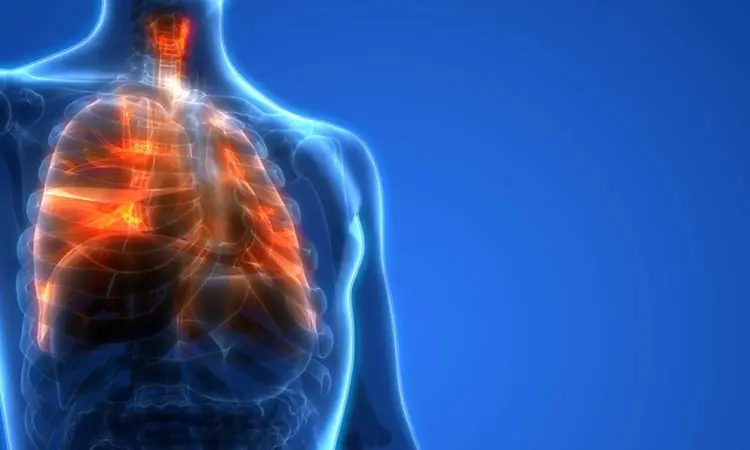- Home
- Medical news & Guidelines
- Anesthesiology
- Cardiology and CTVS
- Critical Care
- Dentistry
- Dermatology
- Diabetes and Endocrinology
- ENT
- Gastroenterology
- Medicine
- Nephrology
- Neurology
- Obstretics-Gynaecology
- Oncology
- Ophthalmology
- Orthopaedics
- Pediatrics-Neonatology
- Psychiatry
- Pulmonology
- Radiology
- Surgery
- Urology
- Laboratory Medicine
- Diet
- Nursing
- Paramedical
- Physiotherapy
- Health news
- Fact Check
- Bone Health Fact Check
- Brain Health Fact Check
- Cancer Related Fact Check
- Child Care Fact Check
- Dental and oral health fact check
- Diabetes and metabolic health fact check
- Diet and Nutrition Fact Check
- Eye and ENT Care Fact Check
- Fitness fact check
- Gut health fact check
- Heart health fact check
- Kidney health fact check
- Medical education fact check
- Men's health fact check
- Respiratory fact check
- Skin and hair care fact check
- Vaccine and Immunization fact check
- Women's health fact check
- AYUSH
- State News
- Andaman and Nicobar Islands
- Andhra Pradesh
- Arunachal Pradesh
- Assam
- Bihar
- Chandigarh
- Chattisgarh
- Dadra and Nagar Haveli
- Daman and Diu
- Delhi
- Goa
- Gujarat
- Haryana
- Himachal Pradesh
- Jammu & Kashmir
- Jharkhand
- Karnataka
- Kerala
- Ladakh
- Lakshadweep
- Madhya Pradesh
- Maharashtra
- Manipur
- Meghalaya
- Mizoram
- Nagaland
- Odisha
- Puducherry
- Punjab
- Rajasthan
- Sikkim
- Tamil Nadu
- Telangana
- Tripura
- Uttar Pradesh
- Uttrakhand
- West Bengal
- Medical Education
- Industry
Study Links Decreased Hemoglobin Levels to Impaired Lung Function and Higher Risk of Airflow Obstruction in Men

South Korea: A recent observational study has shed light on the relationship between hemoglobin (Hb) levels and lung function, revealing a significant association between lower Hb levels and an increased risk of airflow obstruction (AO), particularly in men. The nearly decade-long study showed that higher hemoglobin levels in men were associated with better lung function, including significant improvements in forced vital capacity (FVC), forced expiratory volume in 1 second (FEV1), and the FEV1/FVC ratio.
"Additionally, men experienced a 17% reduced risk of airway obstruction. In women, while higher hemoglobin levels were linked to improved FVC, there was no significant effect on FEV1, FEV1/FVC, or the risk of AO," the researchers reported in BMC Pulmonary Medicine.
Chronic obstructive pulmonary disease (COPD) is a leading cause of mortality and morbidity worldwide, with common comorbidities including cardiovascular disease and depression. Anemia, a frequent COPD comorbidity, is linked to increased mortality and hospitalizations. Recent studies have also explored the relationship between hemoglobin levels and lung function, though findings remain inconclusive. Therefore, Youngmok Park, Institute for Innovation in Digital Healthcare, Yonsei University, Seoul, Republic of Korea, and colleagues aimed to assess the long-term relationship between hemoglobin levels and lung function in a community-based cohort in South Korea.
For this purpose, the researchers employed linear mixed regression analysis to examine the long-term associations between hemoglobin levels and lung function parameters, including forced vital capacity, forced expiratory volume in 1 second, and FEV1/FVC. Additionally, they used a generalized estimating equation to calculate the odds ratio (OR) for airflow obstruction based on Hb levels.
The study led to the following findings:
- Over an 8-year biennial follow-up of 4,468 individuals (median age, 53.9 years; 49.0% men), men showed a positive association between Hb levels and lung function (FVC: 16.7 mL, FEV1: 15.5 mL, FEV1/FVC: 0.18%) and a decreased incidence of AO (OR = 0.83).
- In women, Hb levels were positively associated with FVC (4.7 mL) but not with FEV1 (3.1 mL) or FEV1/FVC (0.01%). The incidence of AO was not significantly different (OR = 0.93).
- In postmenopausal women, higher Hb levels were linked to increased lung function (FVC: 11.8 mL; FEV1: 9.8 mL; FEV1/FVC: 0.09%), but the incidence of AO was not statistically significant (OR = 0.82).
"We explored the long-term relationship between Hb levels and lung function in the general Asian population. Higher Hb levels were linked to improved lung function, and in men, there was a reduced incidence of airway obstruction with rising Hb levels. Thus, a decrease in Hb levels may signal potential lung function impairments," the researchers concluded.
Reference:
Kim, J., Kim, Y.T., Leem, A.Y. et al. Longitudinal association between hemoglobin and lung function with insights into the incidence of airflow obstruction: an observational study. BMC Pulm Med 25, 50 (2025). https://doi.org/10.1186/s12890-025-03505-3
Dr Kamal Kant Kohli-MBBS, DTCD- a chest specialist with more than 30 years of practice and a flair for writing clinical articles, Dr Kamal Kant Kohli joined Medical Dialogues as a Chief Editor of Medical News. Besides writing articles, as an editor, he proofreads and verifies all the medical content published on Medical Dialogues including those coming from journals, studies,medical conferences,guidelines etc. Email: drkohli@medicaldialogues.in. Contact no. 011-43720751


